*We are a reader-supported website. When you buy through links on our site, we may earn a small affiliate commission at no extra cost to you.*
Welcome to Part 2 of our vintage teddy bear identification guide. Today, we’re delving into the fascinating world of authentic vintage teddy bears.
In this segment, we’ll explore tips for spotting a fake or reproduction versus a genuine vintage teddy.
We’ll also discuss tools and resources that can help you identify your teddy bear and uncover its history. Are you ready to dive into the realm of antique plush treasures?
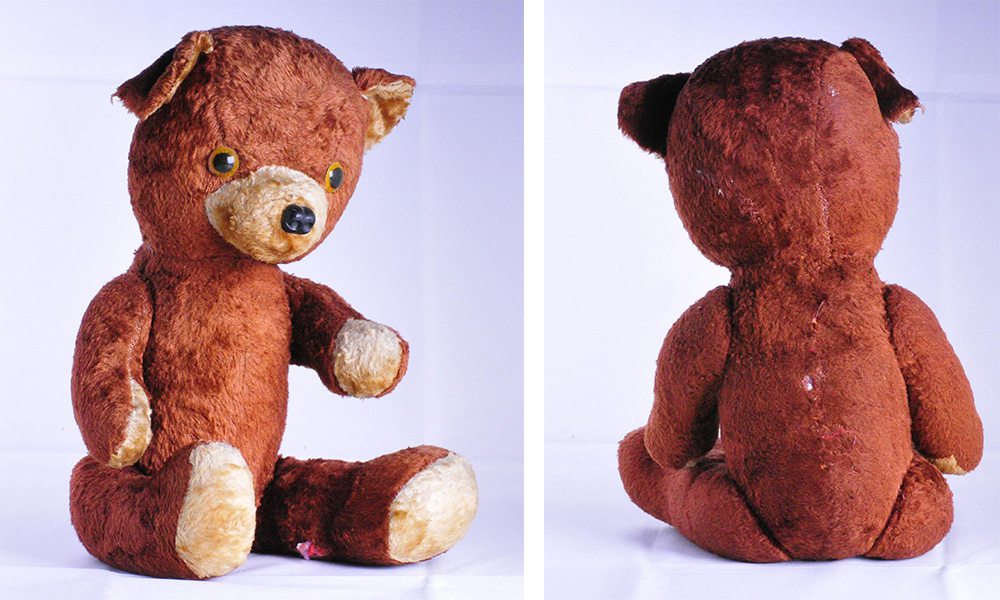
In Part 1, we explored the intricacies of reading and interpreting tags, an essential skill for any serious collector. Understanding the unique features and variations in tags can significantly aid in accurately dating and authenticating your beloved bears.
Tips for Spotting a Fake or Reproduction Vintage Teddy Bear
The charm and value of vintage teddy bears make them highly sought after by collectors worldwide. However, with their popularity comes the risk of encountering fakes or reproductions.
Being able to distinguish between an authentic vintage bear and a replica is essential to ensure that your collection remains genuine and valuable. Here are some comprehensive tips for spotting a fake or reproduction teddy bear.
1. Examine the Materials and Fabric
Authentic vintage teddy bears were often made from high-quality materials that are distinct from those used in reproductions. Here’s what to look for:
- Mohair: Many vintage teddy bears, especially those made in the early 20th century, were crafted from mohair. Mohair is made from the hair of the Angora goat and has a soft, glossy appearance. Reproductions may use synthetic fibers that lack the natural sheen and texture of mohair.
- Wool and Cotton: Some vintage bears were made with wool or cotton plush. Check for signs of wear consistent with aging, such as thinning fabric or fading, which are harder to replicate convincingly.
- Synthetic Fabrics: Bears made post-World War II might use synthetic fabrics. Authentic synthetics from the mid-20th century will have a different feel compared to modern synthetics, often appearing more coarse and less uniform.
2. Check the Construction and Design
The construction and design of a teddy bear can provide crucial clues about its authenticity:
- Jointed Limbs: Many vintage bears have jointed limbs and heads. The joints in genuine vintage bears are often made of metal disks and washers, which should show signs of age and wear. Modern reproductions might use plastic or other newer materials.
- Stitching: Examine the stitching closely. Authentic vintage bears were often hand-stitched, resulting in slightly uneven seams. Mass-produced fakes might have more uniform stitching. Additionally, the thread used in old bears might be cotton or silk, whereas new reproductions might use polyester thread.
- Stuffing: Vintage bears were often stuffed with materials like excelsior (wood wool) or kapok. These materials give the bear a firm feel and might produce a slight rustling sound when squeezed. Modern replicas often use polyester fiberfill, which is softer and more uniform.
3. Scrutinize the Facial Features
Facial features can be highly telling:
- Eyes: Early teddy bears typically had glass eyes, either hand-blown or machine-made. Look for slight imperfections in the glass, such as bubbles or variations in color. Modern reproductions might use plastic eyes, which are smoother and more uniform.
- Noses and Mouths: The noses of vintage bears were often stitched with black or brown thread, sometimes with intricate details. Examine the stitching for signs of aging, such as fraying or discoloration. Reproduction bears might have noses that are too perfect or made from molded plastic.
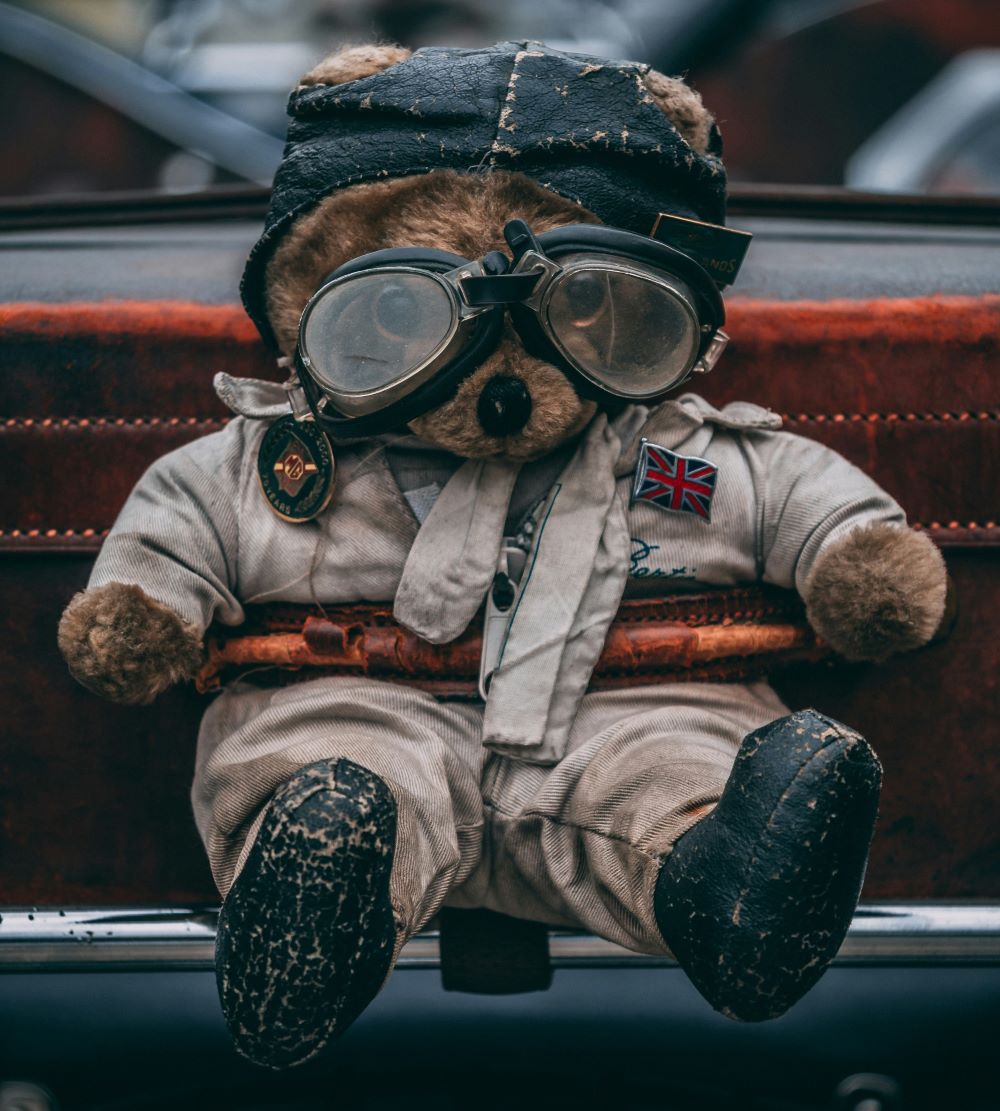
4. Look for Identifying Marks and Labels
Authentic vintage bears often have identifying marks or labels that can help confirm their origin:
- Steiff Bears: Look for the famous “button in ear” trademark. Genuine Steiff buttons are made of metal and often show wear consistent with age. Be wary of buttons that appear too new or lack the correct markings.
- Merrythought Bears: Check for the cloth label sewn into the bear’s foot or side. Authentic labels will show signs of wear and fading. Modern reproductions might use new labels that look too fresh.
- Other Brands: Each manufacturer had its own way of marking their bears. Familiarize yourself with the specific labels and marks used by brands like Chad Valley, Ideal Novelty and Toy Company, Hermann, Dean’s Rag Book Company, and Schuco. Authentic labels should reflect the materials and printing methods of their time.
5. Assess the Condition
While well-preserved vintage bears do exist, many authentic bears will show some signs of age:
- Wear and Tear: Look for consistent wear patterns, such as thinning fur, faded colors, or minor tears. These signs indicate a long history of use and aging.
- Repairs: Many vintage bears have undergone repairs over the years. Authentic repairs might use period-appropriate materials and techniques. Reproduction bears might be made to look aged, but the wear will often be artificial and less consistent.
6. Check for Provenance and Documentation
Provenance can add a layer of authenticity to a vintage teddy bear:
- Original Tags and Packaging: If the bear comes with its original tags or packaging, this can be a good sign of authenticity. Be sure to examine these items for signs of aging and consistency with the era.
- Documentation: Some collectors keep detailed records of their bears’ histories, including purchase receipts, appraisals, or certificates of authenticity. Verify any provided documentation to ensure it matches the bear in question.
7. Consult Experts and Reference Books
When in doubt, consulting an expert can be invaluable:
- Teddy Bear Appraisers: Professional appraisers can provide a thorough examination and offer an expert opinion on a bear’s authenticity.
- Reference Books: There are numerous reference books available that provide detailed information on vintage teddy bears, including pictures, descriptions, and historical context. Using these resources can help you compare and identify features accurately.
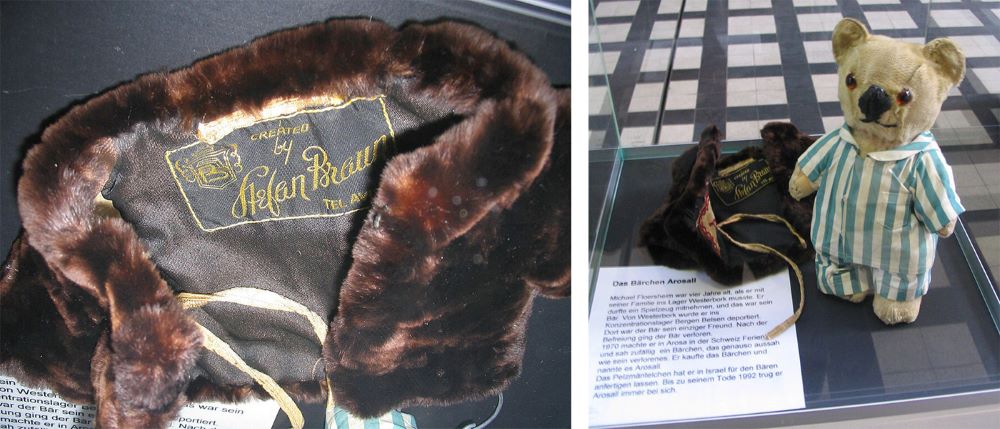
8. Use Technology
Modern technology can assist in verifying authenticity:
- UV Light: Shining a UV light on the bear can reveal repairs or newer materials that fluoresce differently than older fabrics.
- Microscopy: Examining the materials under a microscope can reveal details about the fibers and construction that are not visible to the naked eye.
Spotting a fake or reproduction vintage teddy bear requires careful examination and a keen eye for detail. By thoroughly assessing the materials, construction, facial features, identifying marks, and condition, you can distinguish between genuine vintage bears and modern reproductions.
Additionally, seeking provenance, consulting experts, and utilizing modern technology can further ensure the authenticity of your collection.
Being vigilant and knowledgeable will help you build and maintain a collection of genuine vintage teddy bears, preserving their charm and historical significance.
Tools and Resources for Vintage Teddy Bear Identification
Identifying vintage teddy bears requires a combination of knowledge, experience, and the right tools and resources.
Whether you’re a seasoned collector or a newcomer to the world of vintage teddy bears, having access to the proper tools and resources can significantly enhance your ability to accurately identify and authenticate these cherished toys.
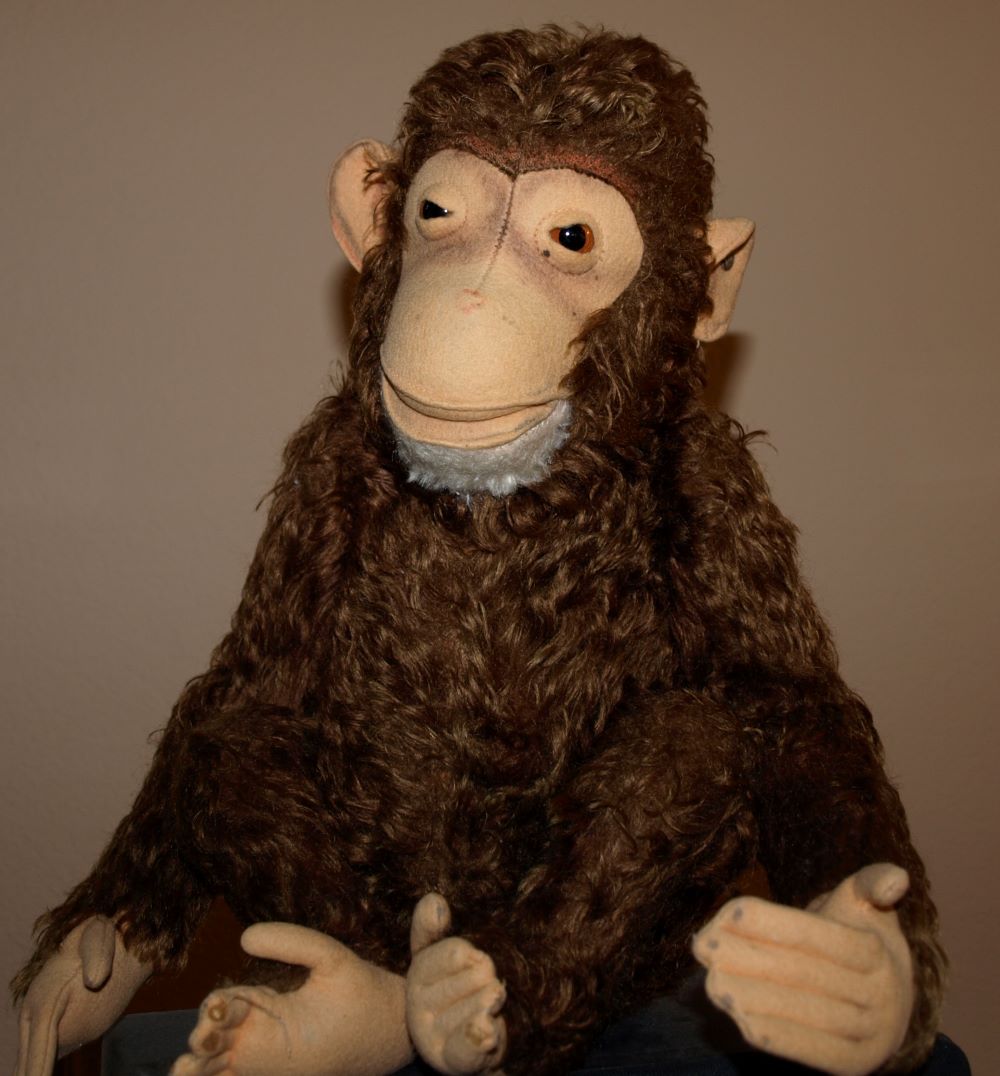
Here are some essential tools and resources to assist you in your identification journey.
1. Reference Books and Guides
Reference books and guides are invaluable resources for anyone looking to identify vintage teddy bears.
These books often contain detailed information, high-quality photographs, and historical context that can help you pinpoint the origin and age of a bear. Some highly recommended titles include:
- “Teddy Bears: A Complete Guide to History, Collecting, and Care” by Sue Pearson: This comprehensive guide covers the history of teddy bears, providing insights into different manufacturers, their unique characteristics, and tips for care and maintenance.
- “The Teddy Bear Encyclopedia” by Pauline Cockrill: This book is an excellent resource for identifying and dating teddy bears from various eras and manufacturers, with detailed descriptions and photographs.
- “A Collector’s History of the Teddy Bear” by Patricia N. Schoonmaker: This book offers an in-depth look at the history and evolution of teddy bears, including information on key manufacturers and their distinctive features.
- “The Teddy Bear Bible” by Susan E. E. McDonald
- “Teddy Bear: Identification and Price Guide” by Julia C. L. Bradbury
2. Online Databases and Websites
The internet is a treasure trove of information for teddy bear enthusiasts. Several websites and online databases provide valuable resources for identifying vintage teddy bears:
- Steiff Online Club: The Steiff website offers a wealth of information about their bears, including a detailed history, production records, and an online archive of their catalogs. Joining the Steiff Club can provide access to exclusive resources and expert advice.
- The Teddy Bear Museum: Many teddy bear museums have online collections and archives that showcase historical bears. These resources can be incredibly helpful for comparing features and identifying specific models.
3. Collector Clubs and Associations
Joining a collector club or association can provide access to a community of experts and fellow enthusiasts who can offer advice and share knowledge:
- The Teddy Bear Club International: This organization connects teddy bear collectors from around the world. Membership often includes access to newsletters, events, and a network of experienced collectors.
- British Teddy Bear Society: This UK-based society offers resources, events, and publications focused on teddy bear collecting. Membership provides access to expert advice and a community of like-minded collectors.
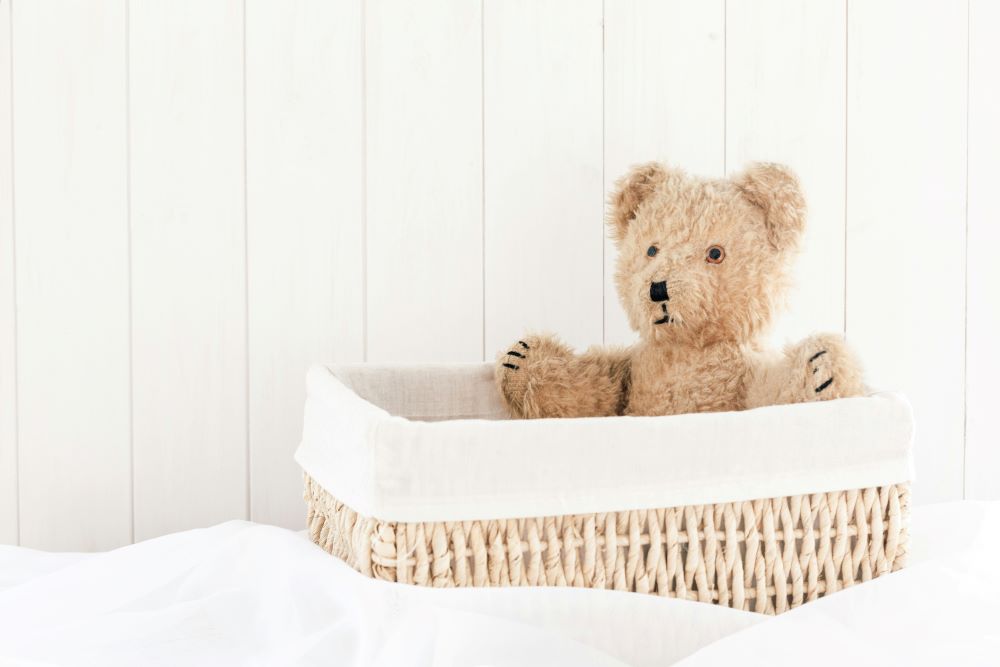
4. Appraisal Services and Experts
When in doubt, consulting with an expert can provide definitive answers about a teddy bear’s authenticity and value:
- Professional Appraisers: Many antique shops and auction houses offer appraisal services for vintage toys, including teddy bears. A professional appraiser can provide a detailed assessment of a bear’s origin, age, and condition.
- Teddy Bear Restorers: Experienced teddy bear restorers not only repair and preserve vintage bears but also possess extensive knowledge about their construction and history. They can offer valuable insights into a bear’s authenticity and provenance.
5. Forums and Social Media Groups
Engaging with online communities can be a great way to share information and seek advice from other collectors:
- Teddy Bear Collector Forums: Participate in online forums dedicated to teddy bear collecting. These platforms allow you to post pictures, ask questions, and share information about your bears with other enthusiasts. Forums can be an excellent source of knowledge and community support.
- Social Media Groups: Join groups on social media platforms like Facebook and Instagram that are dedicated to teddy bear collecting. These groups often have experienced members who can provide identification help, share resources, and offer advice. Engaging with these communities can enhance your collecting experience and connect you with like-minded individuals.
By joining existing forums and social media groups, you can benefit from the collective expertise and support of the teddy bear collecting community.
6. Historical Catalogues and Advertisements
Historical catalogues and advertisements from teddy bear manufacturers can provide crucial information for identifying vintage bears:
- Library Archives: Many libraries have archives of old catalogues and advertisements that can be accessed for research purposes. These documents can help you compare your bear to original images and descriptions.
- Online Archives: Websites like eBay and Etsy often have listings for old catalogues and advertisements. Collecting these materials can provide a valuable reference library for identification.
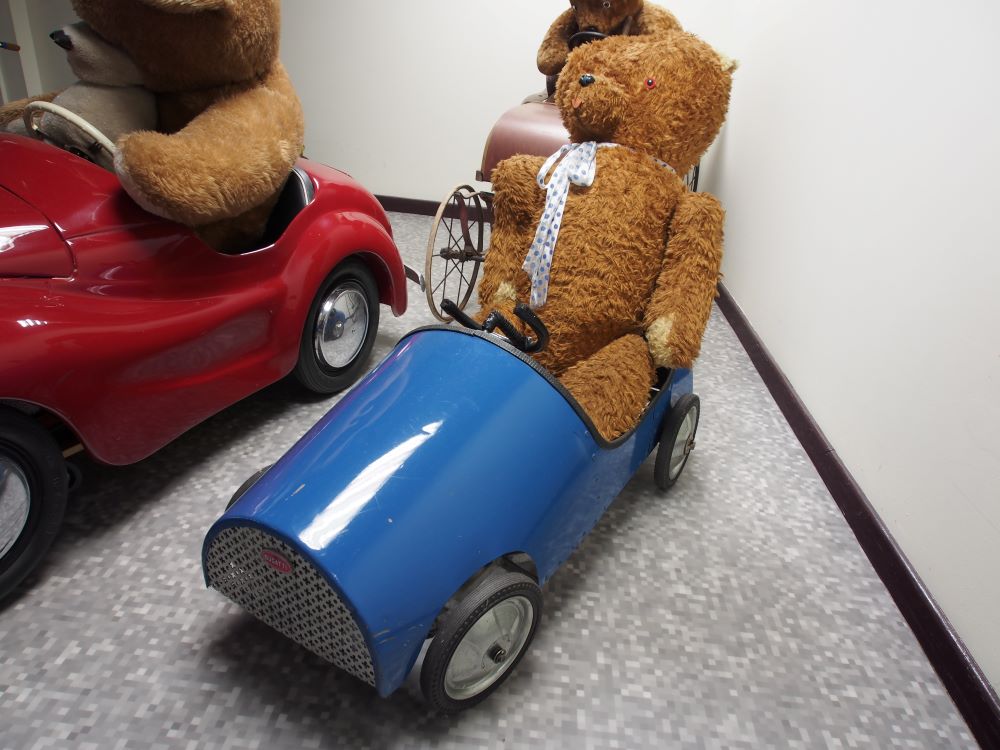
7. Magnification Tools
Detailed examination of a teddy bear’s materials and construction is essential for accurate identification:
- Magnifying Glass: A high-quality magnifying glass can help you closely inspect stitching, labels, and other small details that might not be visible to the naked eye.
- Digital Microscope: A digital microscope can provide even greater magnification and the ability to capture detailed images of the bear’s features. This can be particularly useful for comparing minute details against reference images.
8. UV Light
UV light can be a helpful tool for revealing repairs, newer materials, or other alterations that are not visible under normal lighting:
- UV Flashlight: A portable UV flashlight can help you examine the bear’s fabric and stitching for signs of fluorescence, which may indicate the use of newer materials.
9. Scales and Measuring Tools
Accurate measurement and weighing can provide additional clues about a bear’s authenticity:
- Measuring Tape: Use a measuring tape to record the bear’s dimensions, including height, limb length, and head circumference. These measurements can be compared to known specifications for vintage models.
- Digital Scale: Weighing the bear can help you determine if it matches the expected weight for its size and materials. Significant deviations might suggest reproduction or replacement parts.
10. Professional Appraisers for Teddy Bears
1. Dr. Lori: Dr. Lori offers online appraisals based on actual sales records of similar items. She provides detailed reports considering the condition, provenance, and other factors to determine the fair market value of antique, collectible, or artwork items, including teddy bears.
2. Theriault’s: Specializing in antique dolls and teddy bears, Theriault’s offers free appraisals for items they handle. Their expertise in vintage toys makes them a reliable source for accurate evaluations.
3. Weiss Auctions: Philip Weiss Auctions provides free appraisals for dolls and teddy bears. Known for his appearances on Antiques Roadshow, Phil Weiss’s evaluations are thorough and respected in the antiques community.
4. Pook & Pook: This auction house offers free appraisals for antique dolls and bears. Their reputation for working with discerning collectors makes them a valuable resource for authentic evaluations.
5. Morphy Auctions: Morphy Auctions provides free appraisals and has set auction records in various categories, including teddy bears. They attract a global following of collectors.
Identifying vintage teddy bears is a multifaceted process that requires a combination of tools, resources, and expertise.
By utilizing reference books, online databases, collector clubs, and professional appraisers, you can gather the information needed to authenticate and value your bears
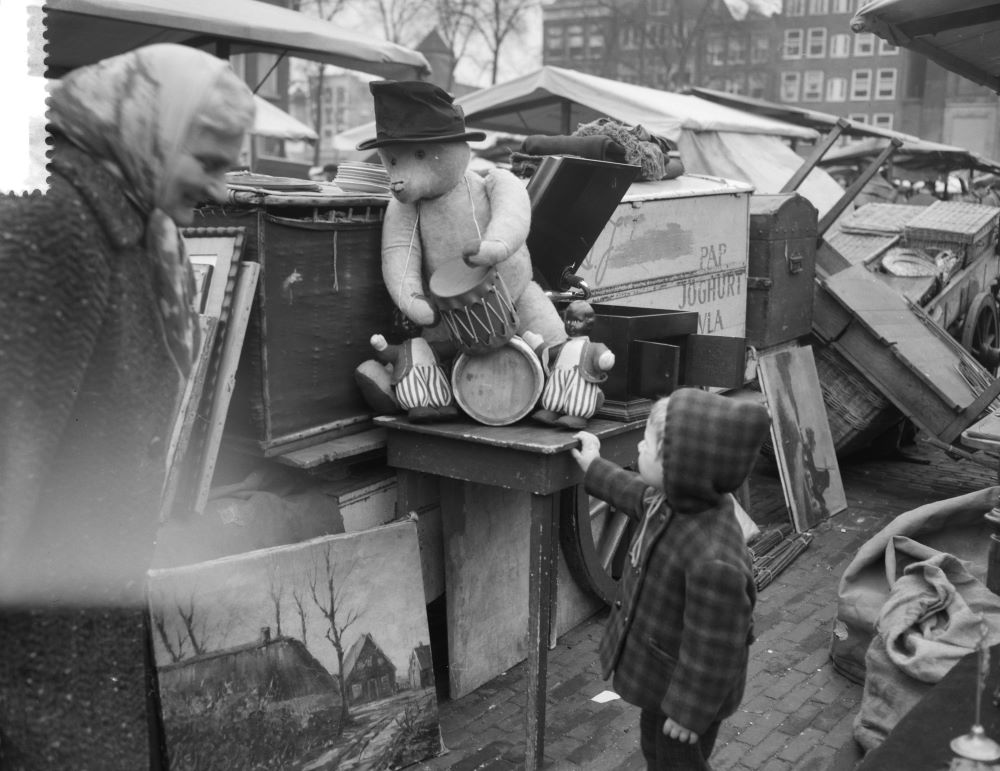
Engaging with online communities and using specialized tools like magnifying glasses, UV lights, and digital microscopes can further enhance your identification efforts.
With the right approach and resources, you can confidently identify and cherish your vintage teddy bear collection, preserving its history and value for future generations.
In Part 3, we dive into identifying antique teddy bears with detailed case studies and provide essential tips on proper storage and care. Ready to uncover the unique features and historical contexts that authenticate these cherished collectibles? Let’s explore!
Mini FAQ: How to Spot Fake Vintage Bears
1. How can I tell if a “vintage” teddy bear is a reproduction?
Look for inconsistencies like overly neat stitching, modern synthetic stuffing (instead of excelsior/kapok), plastic eyes instead of glass, and bright, unworn fabric—all signs it could be a modern copy.
2. Why do glass eyes and jointed limbs matter?
Authentic vintage bears (especially early 20th century) often used glass eyes and were five-way jointed with metal washers. These features are hard to fake convincingly and are good authenticity clues.
3. Do modern materials always mean it’s not vintage?
Mostly yes. Natural mohair, wood-wool (excelsior), kapok, and hand-stitched noses—these materials suggest authenticity. However, be aware of clever restorations that use modern materials to repair some vintage bears.
4. What should I look for in stitching and seams?
Vintage bears often have slightly uneven, visible hand‑stitched seams. Perfect, machine‑made seams usually indicate a reproduction or newer bear.
5. Are brand indicators (like Steiff button‑in-ear) enough to prove authenticity?
They’re helpful but not definitive. Reproductions sometimes include fake buttons or tags. Always cross‑check with materials, stitching, stuffing, and overall wear. For example, genuine early Steiff bears use brass/glass‑eye combos and button with elephant logo in the ear.
6. Can wear and tear prove genuineness?
A bit of wear—like thinning mohair, faded colors, slight material hardening—can support authenticity. But total damage or clean wear? Not necessarily. Consider condition in context with other features.
Join Us for Exclusive Content and Updates!
Are you seeking more inspiration, free patterns, tutorials, and tips for crafting adorable teddy bears? Join our Facebook page for exclusive updates, and don’t forget to subscribe through the Spotlight form towards the beginning of the article—this is your chance to access exclusive content and win teddy bear crafting supplies!
Let’s create together and share the joy of teddy bear art!

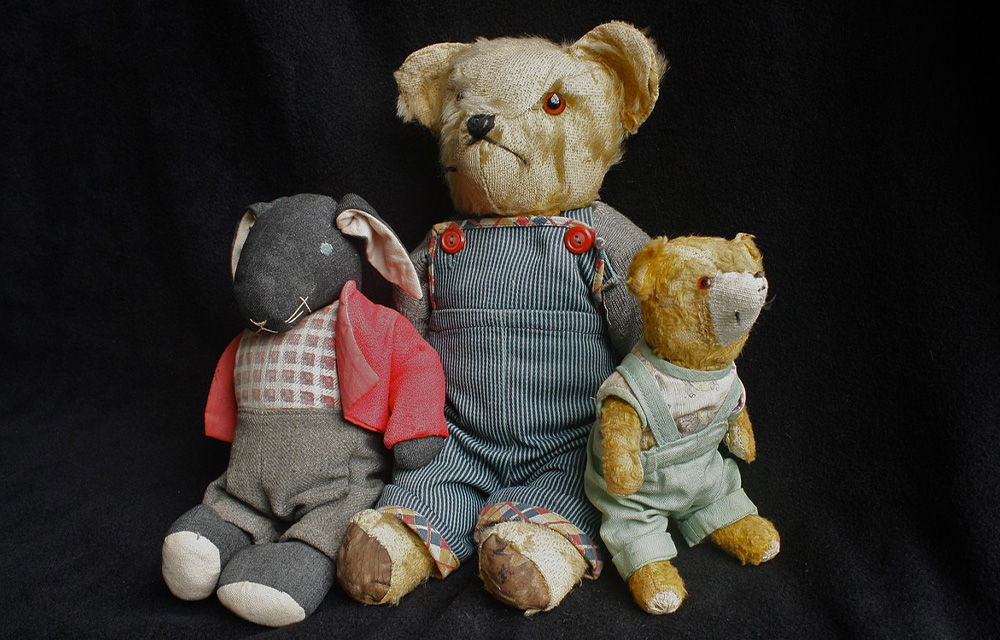
Hey Hanna!
I must say, this ultimate guide to vintage teddy bear identification, tips, and tricks (Part 2) is an absolute treasure trove for teddy bear enthusiasts like myself! The detailed insights and expert advice provided in this article are truly invaluable. From understanding the different types of vintage teddy bears to deciphering their unique characteristics, this guide covers it all. The inclusion of helpful tips and tricks for authenticating and valuing vintage teddy bears is a game-changer for collectors.
Thank you for sharing your expertise and passion for these cuddly companions. This article is a must-read for anyone looking to delve into the world of vintage teddy bear identification. Well done!
Marios
Hi Marios!
Thank you so much for your wonderful comment! I’m thrilled to hear that you found Part 2 of the ultimate guide to vintage teddy bear identification helpful and insightful. It’s always a pleasure to share my passion and knowledge with fellow teddy bear enthusiasts.
Your kind words about the tips and tricks for authenticating and valuing vintage teddy bears mean a lot. It’s great to know that the guide is making a difference for collectors like you.
Happy collecting, and stay tuned for more tips and tricks!
Warm regards,
Hanna
Hi Hanna,
Your guide on vintage teddy bear identification is so fascinating. And I need to know, as a collector, what are some of the most telling features you look for to determine a teddy bear’s age and origin?
Do you have any tips for distinguishing between authentic vintage bears and well-made replicas?
Also, how do you verify the authenticity and value of a teddy bear when considering a new addition to your collection?
I’d love to hear everyone’s insights and experiences as vintage teddy bears have a rich history, and sharing knowledge helps us appreciate them even more!
Hi there!
It’s great to hear that you found the guide on vintage teddy bear identification fascinating. As a collector, there are a few key features to look for when determining a teddy bear’s age and origin.
First, the material is a big clue. Older bears are often made from mohair or other natural fibers, which have a distinctive texture and sheen. In contrast, newer replicas might use synthetic materials. Pay close attention to the stitching and construction as well. Hand-sewn seams are a good indicator of an older bear, and the overall construction quality can tell you a lot about its age.
The eyes and noses of vintage bears are another giveaway. Authentic vintage bears usually have glass eyes and hand-stitched noses, while modern replicas might use plastic eyes and machine-stitched noses. Don’t forget to check for any original tags or labels, which can provide valuable information about the bear’s manufacturer and era. Labels from companies like Steiff, Merrythought, and Schuco can be especially telling.
Distinguishing between authentic vintage bears and well-made replicas can be tricky, but provenance is key. Authentic bears often come with a history of previous owners or documentation, which replicas usually lack. Genuine vintage bears also show signs of age, like worn fur, slightly faded colors, and a certain patina that newer bears just don’t have. And though it might sound odd, older bears often have a musty, vintage smell that newer ones lack. Just be cautious, as some sellers might try to artificially age replicas.
When verifying the authenticity and value of a teddy bear, sometimes it’s best to get an expert appraisal from a recognized expert or a reputable auction house, especially for high-value bears. Using reference books and online databases to compare your bear to known examples is also incredibly helpful. And, of course, engaging with fellow collectors can be invaluable. Sharing photos and details in collector forums or groups often brings insights from those who might have more experience with certain types of bears.
Exploring vintage teddy bears and sharing knowledge not only helps us appreciate them more but also ensures that we preserve this wonderful hobby for future generations. For more detailed information, you can check out the first part of the article on this topic: [Ultimate Guide to Vintage Teddy Bear Identification: Tips and Tricks Part 1](https://teddybearart.com/ultimate-guide-to-vintage-teddy-bear-identification-tips-and-tricks-part-1/).
Looking forward to hearing your tips and experiences too!
Warmly,
Hanna